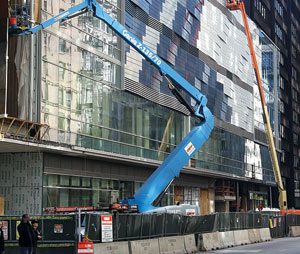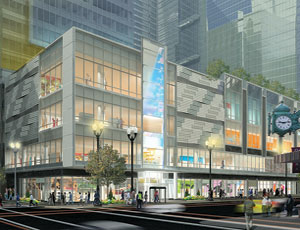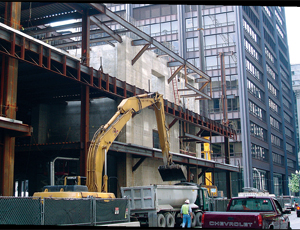It is a race to the finish for “Block 37,” the beleaguered construction site in the Chicago Loop. Just as the first retail tenants ready for their opening day this fall, a consortium of lenders headed by Bank of America Corp. initiated foreclosure proceedings against developer Joseph Freed and Associates LLC.



A lawsuit filed on Oct. 21 claims Freed is in default of more than $128.5 million on a $205 million construction loan. It also asks the court to appoint a receiver to manage the property and finish the project. Freed calls the suit “a misguided action that could halt the project” and plans to fight it vigorously.
“Once shuttered, this project will be near-impossible to restart,” Freed adds, noting that 70% of the space is leased. Mayor Richard M. Daley (D) has met with the lenders in hopes of mediating a compromise between the parties. Meanwhile, construction continues.
The lawsuit is the latest stumbling block to trip up the complicated development. The suit addresses a 60-store retail enterprise located at 108 N. State St. An enclosed mall with a five-story atrium, it is the second completed piece of the mixed-use, multiphase development. A 16-story office building, designed by Ralph Johnson of Chicago’s Perkins + Will, opened in June 2008.
Many Lives, Many Masters
The commercial transformation of Block 37, formerly the last undeveloped site in the Loop, has been a long time coming. Block 37 is one of the original 58 blocks on an 1830 survey, drawn up three years before the city was incorporated. Bordered by State, Washington, Dearborn and Randolph streets, Block 37 is in the thick of the action, near Marshall Field’s flagship department store, now Macy’s, and other attractions.
In 1989, the entire block was cleared, except for an active electrical substation in the center of the Dearborn Street side, to make way for bigger dreams. But the demolition was premature: For more than a decade, the 2.7-acre site lay mostly idle. Several grand plans were announced with fanfare and then abandoned, mostly for financial reasons. Meanwhile, Block 37 served as an ice-skating rink in winter and as an outdoor art gallery in summer.
In 2005, the site was sold to Mills Corp., Chevy Chase, Md. The first phase consisted of an office building, retail mall and underground railway superstation that would connect Chicago Transit Authority’s Red and Blue train lines to add high-speed transportation and baggage check-in to O’Hare and Midway airports. Tunnel work began but was put on hold due to cost escalation, and CTA is seeking a private partner to finish it. A hotel or condominium tower also was planned for the second phase.
Mills sold the office and residential rights to Chicago’s Golub and Co. and kept the retail portion. Construction began, with Chicago’s W.E. O’Neill as general contractor and Thornton Tomasetti Inc. as structural engineer. Mills then fell into financial and legal troubles, prompting it to sell Block 37 interests to Freed. A lawsuit on other matters transferred residential rights to Freed as well.
When Freed took over in spring 2007, Golub’s building was nearing completion, but the retail center was not so far along. Stepping into a work in progress was fun though challenging, says Freed President Larry Freed. “While the Mills Corp. was a public company and, by nature, took a more transitional approach, Freed is a private company that values long-term project ownership,” he says.
Accordingly, the developer “elected to make certain changes,” Freed says, including upgrading finishes. Freed added a green roof, which architect Grant Uhlir of Gensler’s Chicago office suggested in the first place. Mills had vetoed it.
The retail center spans the State Street side, standing four stories above grade. Four underground levels include parking, train platforms and a long-closed...

Post a comment to this article
Report Abusive Comment